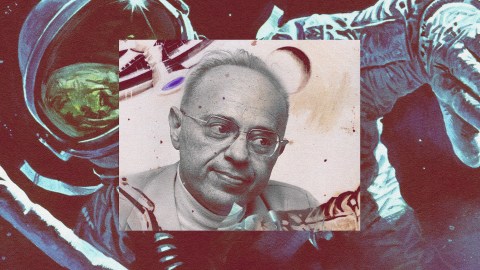How the philosophy of sci-fi legend Stanislaw Lem can help us understand AI

- Multiple AI companies christened their products after Lem’s 1961 sci-fi classic, Solaris.
- In Lem’s Summa Technologiae we find hypotheses on the nature of technology and how it mediates human knowledge and evolution.
- Lem is a formidable technology theorist whose work aligns with contemporary media theory.
Stanislaw Lem’s first-contact novel Solaris (1961) is the Polish writer’s most celebrated and enduring legacy. It features an ocean planet that conjures up life with no apparent purpose, at best perversely reflecting human wounds and desires. Unintelligible, alien, and therefore not easily communicable, the ocean in Solaris could be an archetype of inhuman intelligence: indifferent, foreign, and creative in its distorted reflection of humanity. A quick Google search reveals that multiple artificial intelligence (AI) companies christened their products after Lem’s novel. Solaris could be a prototype for computational cognition design that is not human-centred: ‘that inscrutable alien might be wise or cruel or unconcerned’, not an all-seeing God but rather ‘a nebular and numinous totality . . . [a] big alien brain’ (Bratton, 2020, p. 97).
Summa Technologiae (1964a), Lem’s abstruse, 600-page-long theoretical work is less known, though it contains the rationale for his whole oeuvre. Titled after Summa Theologica (written 1265–1273, published 1485) by St. Thomas Aquinas, Lem’s philosophical tour de force might make one reread Solaris, and its descriptions of inhuman intelligence, as a theological—at least, metaphysical— problem. Indeed, many of Lem’s novels trace the limits of knowledge in an indifferent cosmos. Overviewing the most cutting-edge scientific discourses of the times, Summa is a work of futurology composed of eight chapters, each of which reframes theological questions as technological problems. The first chapter presents Lem’s views on the purpose of futurology, and subsequent chapters discuss similarities between technological and biological evolution; SETI; the possibility of computational intelligence; whether humans could be technologically omnipotent; whether humans could create artificial worlds and virtual cosmoses enclosed in themselves; machine knowledge; and whether humans could, akin to gods, engineer new lifeforms.
[…]
Lem is one of only a few writers from beyond the anglophone scene who made it into the popular global canon of science fiction. Recent monographs on his work in English (Gajewska, 2021), new widely reviewed English translations distributed by MIT Press and published together with essays by media scholars such as Katherine Hayles, and multiple events held globally to celebrate the hundredth anniversary of his birthday, prove that there is a rise of interest in his work. This happens alongside a general rise of interest in technological narratives beyond western Europe and the US.
Solaris could be a prototype for computational cognition design that is not human-centred.
Questions have appeared, for example, about what ‘non-western AI’ might be, but when ‘non-western perspectives’ are brought up, they can sometimes be essentialized as ‘better’ or even inherently more moral for AI design—they are argued to be more ‘pluralistic’, ‘metaphysically inclusive’, ‘relational’, or ‘ethical’ than the ‘western scientific ones’ (Goffi, 2021; Hui and Amaro, 2020; Vickers and Allado-McDowell, 2020). Various local belief systems can appear as exoticized ‘others’ to be deployed in the ethical redesigning of ‘Western AI’ into a seemingly more relational, harmonious, and pacified technology (Williams and Shipley, 2021).
Given its ambivalent position with regards to the ‘West’ — whether Poland is ‘east’ or ‘west’ has been hotly debated for at least a couple centuries (Czaplin ́ski, 2016) — we find no proximate salvation discourse projected onto Eastern Europe. It is not perceived as foreign ‘enough’ to serve as a useful foil against which mainstream American technology discourse can evaluate its ‘ethical failings’. In fact, Summa sets out not to take an ethical perspective and instead takes a disinterested, detached look at technology’s role in human evolution.
Summa Technologiae (1964a), Lem’s abstruse, 600-page-long theoretical work […] contains the rationale for his whole oeuvre.
Rather than taking an ‘AI ethics’ or ‘area studies’ approach to Lem’s work, I prefer to see him as a formidable technology theorist whose work is in line with contemporary media theory and can enrich its canon. Though some attention is devoted to Central and Eastern European media and technology studies, it is mostly within the areas of news media, communications, and political economy (Demeter, 2020; Downey and Mihelj, 2012). We are yet to see serious attempts at media theory—or philosophy—in the tradition of Haraway (1991), Hayles (1999) or McLuhan (1964) to come from this region; that is, an inquiry into how technological mediation revises certain fundamental axioms of humanism. Lem’s interest lies precisely in that, to the extent that he even discards human-centred ethics as a relevant perspective. Summa cannot be used to redeem perceived sins of ‘Western AI’, but it does contribute hypotheses on the very nature of technology and how it mediates human knowledge and evolution.





